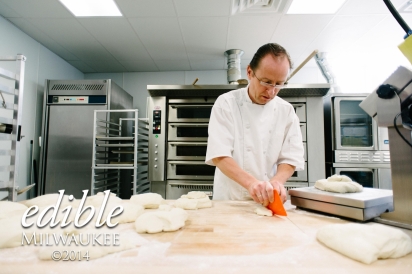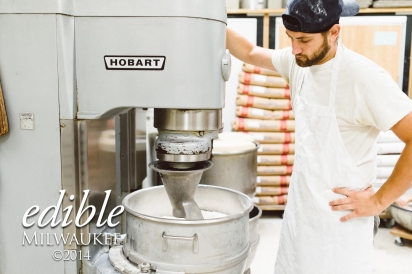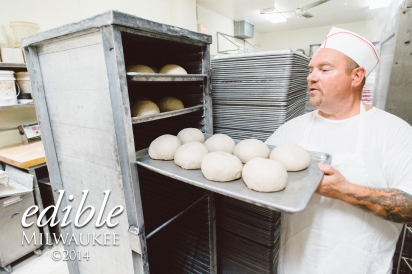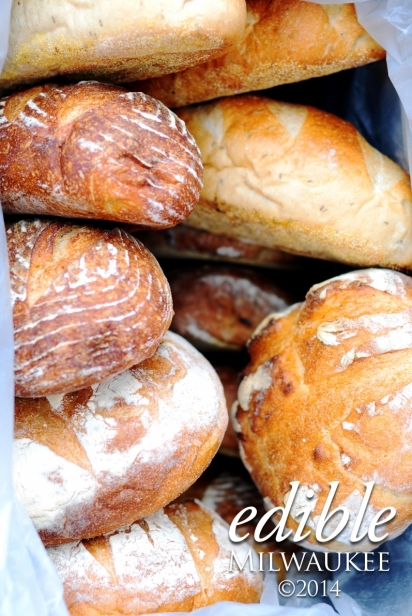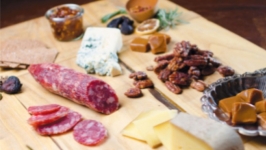Get Your Hands Into the Stuff of Life
Making bread a matter of practice, patience for home bakers
Four. Water. Salt. Yeast. Bread. The “stuff” of life. It is an old adage in all cooking that the simpler and fewer the ingredients the more important technique is. Bread baking is the quintessential expression of this maxim. Successful bread making is wholly about technique. Yes, there are subtleties achieved through changes in the types of flour, salt, yeast, and even water used in a recipe. And of course, you can boost flavor with herbs, fats, and other tasty additions. But at its core, bread is about the toothsome bite of the crust and the soft chew of the crumb—qualities only achieved through proper technique.
The revolution in bread baking of the past decade is to look backwards at how our ancestors made bread. With science at our fingertips, we now know how that alluring mixture of flour, water, salt, and yeast behave together and how to better utilize the two unmentioned ingredients needed for all bread: time and temperature.
I spoke with Gene Webb, owner of North Shore Boulangerie. Before following his dream of baking French-style breads, he studied yeast biogenics. From his academic studies, he understood how and why yeasts behave; they are a living organism needing a food source, moisture, and an ideal temperature. But what he didn’t know is the relationship between simple ingredients and the proper techniques. “Bread leaves nowhere to hide. You know when it’s right. You know when it’s wrong.”
Webb studied at the French Pastry School in Chicago and worked with master bakers in Chicago and Paris to learn the essence of what makes great bread. “At its core, bread is just baked wheat paste. What adds flavor is yeast.” When yeast is fed by salt, flour and water at the correct temperature it transforms into the tasty loaf we’re striving to create. He is an advocate of regular, active yeast for home bakers. “The advent of quick-rise yeasts killed home baking. Quick yeasts aren’t really behaving as true yeasts; they’re not digesting the starch.”
How does that distinctive taste happen? As yeast grows, it consumes the starches in flour to release carbon dioxide. It’s what makes the crumb light, the texture soft, and the taste slightly sweet-sour. Webb adds, “Many people (who are not celiac) who have stomach problems from eating breads are not having a reaction to gluten; they’re reacting to the high levels of starch in commercial breads made with quick yeasts. We’ve forgotten what bread tastes like.”
Think of it this way: the yeast you use in a bread dough is the same strain as used in beer. Beers, wines, any foods that utilize a yeast need a fermentation period. That is the missing element in many American-style bread recipes. We allow for a dough to ‘rest’ or ‘rise’ for a couple of hours, but that’s nowhere near enough time to allow for a light, airy loaf with a firm crust. Using the long ferment time allows the bread to develop natural gluten strands without kneading. This also is why French-style breads have a more open crumb.
Joe Blaine is Head Baker at National Bakery, a Milwaukee institution since 1923. I wanted to learn from Blaine what makes their breads the perfect sandwich bread. He agrees that yeast is very important. At National, they employ a 24-hour cycle, making the doughs on one day, then baking the next, thereby allowing the yeast to ferment.
This time is critical for all bread doughs. When letting your dough rise at home, you want to first create a warm and humid environment for the yeast to grow rapidly. Then you want to slow the fermentation down with a drop in temperature, but without losing moisture. For home bakers, a stoneware bowl is the right tool for the job. Dough placed into a bowl, covered with plastic wrap, and placed on top of a counter or stove will do the trick.
Blaine pointed out that flour can definitely make a difference in your bread. Both he and Webb utilize an unbleached all-purpose flour. But, Blaine says using a bread flour that is higher in gluten (more fiber strands) will result in a stronger, tougher finish. This is great for hard rolls, but maybe not what you want for a sandwich bread.
For sandwich breads, they’re looking for more densely stacked gluten strands. This gives a lighter bread but with a dense crumb. Big holes in a slice aren’t ideal for sandwich making! To help achieve this dense crumb, National adds fat to the dough, which could be butter, lard, or oil depending on the recipe. Fat impedes gluten development as it binds with the moisture. Fat also conditions the dough and makes the final product softer.
Kneading dough is often something dreaded by home bakers. At North Shore Boulangerie, their doughs aren’t kneaded, just mixed; the yeast is doing the work of building the structure. At National Bakery, breads are kneaded. This process helps develop the gluten strands more tightly, helping to achieve a dense crumb. Blaine laughs, “No one works a dough on the board for hours anymore!” He says that though they still make their recipes according to the original recipes they have adopted some modern technological advances. He points proudly to the giant Hobart mixer, “This is the same machine, made by the same company, as a Kitchen Aid. Use a dough hook! You’ll never want to knead again. A couple minutes with the dough hook replaces who knows how long kneading.”
Both Webb and Blaine also say that commercial ovens are different than home ovens. “People don’t realize that bread from a bakery is really baked in two stages; the first part of the baking utilizes steam,” says Webb. Blaine adds, “Steam gets absorbed early in the process and gives you a shiny, crisp crust. Without the steam, you’ll end up with a thick, dull and cracked finish.”
Both experts suggested a few hacks to replicate their steam ovens in a home setting. Blaine opts for a jelly roll pan filled with water placed at the bottom rack of your oven. Webb favors a cake pan on the bottom rack in which you toss some ice cubes. Either method will help you achieve your perfect loaf.
I asked about whole grain and rye breads. Webb said that rye flours can be tricky, they tend to absorb moisture at an uneven rate. At National Bakery, their rye loaves are a balanced mix of rye and unbleached wheat flour. Start with a basic bread, then work your way up to rye flours is the advice from both master bakers. According to Webb, “Don’t be too hard on yourself. The key is to never be satisfied but always be accepting and know that the recipe is not dogma; play with the dough, make adjustments.”
As we welcome fall and thoughts turn to home and hearth, I challenge all of you to rediscover the joy of bread baking.
Webb offers a final word of advice, “Courage! As long as you enjoy the results, keep doing it!”
Bread Baking Tips
Tips and tricks from Gene Webb and Joe Blaine:
- Use weight, not volume to measure ingredients.
- Pay attention to humidity; humidity changes doughs.
- Don’t use quick rise yeasts!
- Give yeasts a full 24 hours to ferment.
- When working with wetter doughs, don’t use too much flour in the shaping. It can be absorbed into the dough and cause scarring.
- If using a stand mixer, use your dough hook attachment!
- As you shape loaves, save the end bits in a bin in the refrigerator. These can be re-used and develop even more flavor.
- When shaping, don’t overwork the dough.
- Wood is the best work surface. It holds the temperature of the dough steady.
- Use a baking stone (pizza stone) to achieve even crust and thorough baking when making artisan style breads.
- Avoid fleximold pans (silicone).
- Use parchment paper; it makes moving loaves easier and prevents sticking.
- Use the pan of water or ice cube method to replicate the two-stage steam baking of professional ovens. It will take a few times to learn your own oven, but cracks or ruptures on the top of a loaf is a sign that it’s too dry.
- Try finishing off your baking time with the oven door slightly open for the last 15 minutes.
The breaking and sharing of bread is the symbol of fellowship throughout the world. I invite you to share that. Send us your pictures at art@ediblemilwaukee.com or post them to our Facebook page.



